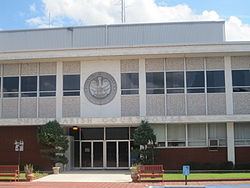Area 2,344 km² Population 22,344 (2013) Unemployment rate 7.2% (Apr 2015) | Time zone Central: UTC-6/-5 Founded 1839 Largest city Farmerville | |
 | ||
Named for Union of American states Rivers Ouachita River, Bayou D'Arbonne, Corney Bayou | ||
Sunrise in downtown tigerbend union parish louisiana
Union Parish (French: Paroisse de l'Union) is a parish located in the U.S. state of Louisiana. As of the 2010 census, the population was 22,721. The parish seat is Farmerville. The parish was created on March 13, 1839, from a section of Ouachita Parish. Its boundaries have changed four times since then (in 1845, 1846, 1867, and 1873, respectively).
Contents
- Sunrise in downtown tigerbend union parish louisiana
- Map of Union Parish LA USA
- Union ParishUnion County monument
- Geography
- Major highways
- Adjacent parishes and counties
- National protected areas
- Demographics
- Politics
- Education
- Towns
- Villages
- Unincorporated communities
- Notable residents
- References
Map of Union Parish, LA, USA
Union Parish is part of the Monroe, LA Metropolitan Statistical Area.
Union Parish/Union County monument
In 1931, a monument was erected at the Union Parish border with Union County, Arkansas, through the private efforts of former Arkansas Governor George Washington Donaghey (1856–1937). He was born in Union Parish and grew up in the border area before moving with his family as a teenager to Conway, Arkansas. As governor of Arkansas, Donaghey oversaw the construction of the state capitol building in Little Rock and implemented founding of the state health unit and its agricultural colleges.
Long having felt a kinship to both states, after his gubernatorial tenure Donaghey commissioned a park on the border land and a monument. The monument is known for its intricate carvings and Art Deco style. It includes references to different modes of transportation in 1831 and 1931 and mentions Louisiana Governor Huey P. Long, Jr., whose educational program Donaghey admired. The land was not registered with the state parks offices in either state, timber companies cut trees thereabouts, and the monument was forgotten. In 1975, State Representative Louise B. Johnson gained passage of a law to refurbish the monument. A completed restoration was unveiled in 2009.
Geography
According to the U.S. Census Bureau, the parish has a total area of 905 square miles (2,340 km2), of which 877 square miles (2,270 km2) is land and 28 square miles (73 km2) (3.1%) is water.
Geographically north central Louisiana and more closely resembles Lincoln Parish, to which Union is deeply tied culturally, politically, and educationally. The Piney Hills Country is very different from the flat, hardwood delta lands of northeastern Louisiana.
Major highways
Adjacent parishes and counties
Union Parish in Louisiana and Union County in Arkansas are two of twenty-two counties or parishes in the United States with the same name to border each other across state lines. The others are Big Horn County, Montana and Big Horn County, Wyoming, Sabine County, Texas and Sabine Parish, Louisiana, Bristol County, Massachusetts and Bristol County, Rhode Island, Kent County, Maryland and Kent County, Delaware, Escambia County, Alabama and Escambia County, Florida, Pike County, Illinois and Pike County, Missouri, Teton County, Idaho and Teton County, Wyoming, Park County, Montana and Park County, Wyoming, San Juan County, New Mexico and San Juan County, Utah, and Vermilion County, Illinois and Vermillion County, Indiana. respectively. (Note, despite the different spellings, the source of the name is the same for Vermilion County, Illinois and Vermillion County, Indiana—the Vermillion River which flows through both counties.)
National protected areas
Demographics
As of the census of 2000, there were 22,803 people, 8,857 households, and 6,412 families residing in the parish. The population density was 26 people per square mile (10/km²). There were 10,873 housing units at an average density of 12 per square mile (5/km²). The racial makeup of the parish was 69.79% White, 27.95% Black or African American, 0.19% Native American, 0.26% Asian, 0.05% Pacific Islander, 1.26% from other races, and 0.50% from two or more races. 2.02% of the population were Hispanic or Latino of any race.
There were 8,857 households out of which 31.30% had children under the age of 18 living with them, 55.30% were married couples living together, 13.70% had a female householder with no husband present, and 27.60% were non-families. 24.90% of all households were made up of individuals and 11.00% had someone living alone who was 65 years of age or older. The average household size was 2.52 and the average family size was 3.01.
In the parish the population was spread out with 25.70% under the age of 18, 9.10% from 18 to 24, 26.50% from 25 to 44, 23.80% from 45 to 64, and 14.90% who were 65 years of age or older. The median age was 37 years. For every 100 females there were 94.50 males. For every 100 females age 18 and over, there were 90.90 males.
The median income for a household in the parish was $29,061, and median income of a family was $36,035. Males had a median income of $30,494 versus $21,070 for females. The per capita income for the parish was $14,819. About 14.30% of families and 18.60% of the population were below the poverty line, including 25.60% of those under age 18 and 17.70% of those age 65 or over.
Politics
Located in far northern Louisiana next to the Arkansas state line, Union Parish is heavily Republican in most competitive elections, particularly at the presidential level. In 2012, Mitt Romney received 7,561 votes (70.2 percent) of the parish total to 3,075 (28.6 percent) for U.S. President Barack Obama.
Education
Residents are assigned to Union Parish Public Schools.
Towns
Villages
Unincorporated communities
Notable residents
Two Louisiana governors came from the Shiloh Community in Union Parish:
Two Arkansas governors were natives of Union Parish:
Other Union Parish residents have included:
